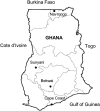Selective sweeps and genetic lineages of Plasmodium falciparum drug -resistant alleles in Ghana
- PMID: 21288822
- PMCID: PMC3071065
- DOI: 10.1093/infdis/jiq038
Selective sweeps and genetic lineages of Plasmodium falciparum drug -resistant alleles in Ghana
Abstract
Background: In 2005, Ghana adopted artemisinin-based combination therapy (ACT) for primary treatment of falciparum malaria. A comprehensive study of the drug-resistance-associated mutations and their genetic lineages will lead to a better understanding of the evolution of antimalarial drug resistance in this region.
Methods: The pfcrt, pfmdr1, dhps, and dhfr mutations associated with chloroquine (CQ) and sulfadoxine-pyrimethamine (SP) resistance and the microsatellite loci flanking these genes were genotyped in Plasmodium falciparum isolates from Ghana.
Results: The prevalence of mutations associated with both CQ and SP resistance was high in Ghana. However, we observed a decrease in prevalence of the pfcrt K76T mutation in northern Ghana after the change in drug policy from CQ to ACT. Analysis of genetic diversity and differentiation at microsatellite loci flanking all 4 genes indicated that they have been under strong selection, because of CQ and SP use. The triple-mutant pfcrt and dhfr alleles in Ghana were derived from Southeast Asia, whereas the double-mutant dhfr, dhps, and pfmdr1 alleles were of African lineage.
Conclusion: Because of the possible role of pfmdr1 in amodiaquine and mefloquine resistance, demonstrating selection on pfmdr1 and defining lineages of resistant alleles in an African population holds great importance.
Figures



References
-
- Koram KA, Abuaku B, Duah N, Quashie N. Comparative efficacy of antimalarial drugs including ACTs in the treatment of uncomplicated malaria among children under 5 years in Ghana. Acta Trop. 2005;95:194–203. - PubMed
-
- Neequaye J. In vivo chloroquine-resistant falciparum in Western Africa. Lancet. 1986;327:153–4. - PubMed
-
- Quashie NB, Duah NO, Abuaku B, Koram KA. The in vitro susceptibilities of Ghanaian Plasmodium falciparum to antimalarial drugs. Ann Trop Med Parasitol. 2007;101:391–8. - PubMed
-
- Duah NO, Wilson MD, Ghansah A, et al. Mutations in Plasmodium falciparum chloroquine resistance transporter multidrug resistance genes, and treatment outcomes in Ghanaian children with uncomplicated malaria. J Trop Pediatr. 2007;53:27–31. - PubMed
-
- Ehrhardt S, Mockenhaupt FP, Agana-Nsiire P, et al. Efficacy of chloroquine in the treatment of uncomplicated, Plasmodium falciparum malaria in northern Ghana. Ann Trop Med Parasitol. 2002;96:239–47. - PubMed

